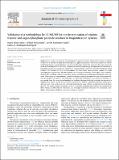Mostrar el registro sencillo del ítem
Validation of a methodology by LC-MS/MS for the determination of triazine, triazole and organophosphate pesticide residues in biopurification systems
| dc.creator | Masís Mora, Mario Alberto | |
| dc.creator | Beita Sandí, Wilson | |
| dc.creator | Rodríguez Yáñez, Javier E. | |
| dc.creator | Rodríguez Rodríguez, Carlos E. | |
| dc.date.accessioned | 2021-03-10T22:19:52Z | |
| dc.date.available | 2021-03-10T22:19:52Z | |
| dc.date.issued | 2020 | |
| dc.identifier.citation | https://www.sciencedirect.com/science/article/pii/S1570023220307972 | |
| dc.identifier.issn | 1570-0232 | |
| dc.identifier.uri | https://hdl.handle.net/10669/83021 | |
| dc.description.abstract | Biopurification systems are useful in the management of pesticide residues and provide an option to dispose wastewaters of agricultural origin derived from pesticide application practices. The analysis of pesticide residues in the biopurification system biomixture is necessary to determine whether the removal of the target compounds occurs with reliable results. In this study, the pesticide extraction methodology was optimized and validated in a biomixture composed of coconut fiber, compost and soil, to determine a total of 43 molecules, distributed among triazines (10), triazoles (13) and organophosphates (20) using liquid chromatography coupled to a triple quadrupole mass spectrometer. For the validation, the parameters of linearity, matrix effect, limit of determination (LOD), specificity, selectivity, precision, trueness and robustness in the proposed biomixture were evaluated. The analyses of those parameters revealed satisfactory results of the method for most of the compounds, with the exception of diclorvos and ciromazine, for which the development of an alternative method is recommended. Once the extraction methodology was validated, the removal of eight molecules was assayed in a biopurification system used for the simultaneous treatment of a mixture of pesticide commercial formulations. Although most of the compounds were at least partially removed, none of them was eliminated at levels below the LOD. The removal pattern of ametryn, atrazine, chlorpyrifos, malathion and terbutryn was comparable to those obtained in other efficient biomixtures, and the highly recalcitrant triadimenol was eliminated; nonetheless, tebuconazole and diazinon were not significantly removed. | |
| dc.source | Journal of Chromatography B, Vol. 1156: pp. 122296 | |
| dc.subject | Biomixture | |
| dc.subject | Biopurification system | |
| dc.subject | LC-MS/MS | |
| dc.subject | Pesticides | |
| dc.subject | Validation methodology | |
| dc.title | Validation of a methodology by LC-MS/MS for the determination of triazine, triazole and organophosphate pesticide residues in biopurification systems | |
| dc.type | artículo original | |
| dc.identifier.doi | 10.1016/j.jchromb.2020.122296 | |
| dc.description.procedence | UCR::Vicerrectoría de Investigación::Unidades de Investigación::Ciencias Básicas::Centro en Investigación en Contaminación Ambiental (CICA) | |
| dc.identifier.codproyecto | 802-B4-503 |
Ficheros en el ítem
Este ítem aparece en la(s) siguiente(s) colección(ones)
-
Biología [1644]


